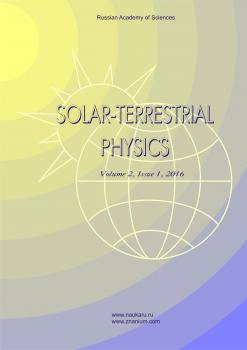Иркутск, Россия
Иркутск, Россия
Using flare patrol data for 1972–2010 [http://www.ngdc.noaa.gov/stp/space-weather/solar-data/solar-features/solar-flares/], we have conducted statistical studies of small solar flares. We have established a correlation between the flare brightness rise time and the total duration of small flares, and obtained evidence of the discreteness of relative rise times (Trel). The most significant Trel values are 0.2, 0.25, 0.33, and 0.5. As the area class and importance of flares increase, maxima of Trel distributions decrease, flatten, and completely disappear in case of large flares. We have found the discreteness of the area distribution of small flares. We have obtained distributions of solar flare energy, which exhibit significant overlap for flare energy of different area classes. The energy range of large solar flares contains 9.5 % of small flares. The energy range of flares of area class 1 has even a more significant overlap.
solar flares
1. Borovik A.V. Solar flares and supergranulation structure of active regions. Issledovaniya po geomagnetizmu, aeronomii i fizike Solntsa [Res. on geomagnetism, Aeronomy and Solar Phys.]. 1990, iss. 91, pp. 141-144. (In Russian).
2. Borovik A.V. Statistical parameters and fine structure elements of small solar flares. Issledovaniya po geomagnetizmu, aeronomii i fizike Solntsa [Res. on geomagnetism, Aeronomy and Solar Phys.].1994, iss. 102, pp. 161-177. (In Russian).
3. Borovik A.V., Zhdanov A.A. Statistical studies of low-power solar flares. Distribution of flares by area, brightness, and classes. Solar-Terr. Phys. 2017a, vol. 3, no. 1, pp. 40-56. DOI:https://doi.org/10.12737/article_58f96fda7e3e76.83058648.
4. Borovik A.V., Zhdanov A.A. Statistical research into low-power solar flares. Main phase duration. Solar-Terr. Phys. 2017b, vol. 3, no. 4. P. 5-16. DOI:https://doi.org/10.12737/stp-34201701.
5. Borovik A.V., Zhdanov A.A. Statistical studies of duration of low-power solar flares. Solar-Terr. Phys. 2018a. vol. 4, no. 2, pp. 8-16. DOI:https://doi.org/10.12737/stp-42201803.
6. Borovik A.V., Zhdanov A.A. Distribution of low-power solar flares by brightness rise time. Solar-Terr. Phys. 2018b, vol. 4, no. 3, pp. 3-12. DOI:https://doi.org/10.12737/stp-43201801.
7. Fletcher L., Dennis B.R., Hudson H.S., Krucker S., Phillips K., Veronig A., et al. An observational overview of solar flares. Space Sci. Rev. 2011, vol. 159, pp. 19-106. DOI:https://doi.org/10.1007/s11214-010-9701-8.
8. Kurochka L.N., Stasjuk L.A. Radiation energy of optical solar flares, I. Solnechnye dannye [Solar Data]. 1981, no. 5, pp. 83-91. (In Russian).
9. Kurochka L.N., Rossada V.M. Radiation energy of optical solar flares, II. Solnechnye dannye [Solar Data]. 1981, no. 6, pp. 78-83. (In Russian).
10. Kurochka L.N., Rossada V.M. Radiation energy of optical solar flares, III. Solnechnye dannye [Solar Data]. 1981, no. 7, pp. 95-104. (In Russian).
11. Masuda S., Kosugi T., Hara H., Tsuneta S., Ogawara Y. Loop-top impulsive hard X-ray source of a solar flare as evidence for magnetic reconnection. Nature. 1994, vol. 371, pp. 495-497. DOI:https://doi.org/10.1038/371495a0.
12. Neupert W.M. Comparison of solar X-ray line emission with microwave emission during flares. The Astrophys. J. 1968, vol. 153, pp. L59-L64. DOI:https://doi.org/10.1086/180220.
13. Ogir’ M.B. Some types of movements in chromospheric flares. Izvestija Krymskoi astrofizicheskoi observatorii [Bull. of the Crimean Astrophysical Observatory]. 1970, vol. 16-17, pp. 25-44. (In Russian).
14. Priest E. Solnechnaya magnitogidrodinamika [Solar Magnetohydrodynamics]. Moscow, Mir Publ., 1985, 592 p. (In Russian).
15. Priest E.R. Solar flare MHD processes. Pub. Astron. Inst. Acad. Sci. Czech. Republic. 1992, vol. 88, pp. 95-120.
16. Raman S.K., Aleem S.M., Singh J., Selvendran R., Thiagarajan R. H-alpha flare of 14 March, 1984 − Evidence for reconnection? Solar Phys. 1994, vol. 149, no. 1, pp. 119-127. DOI:https://doi.org/10.1007/BF00645182.
17. Roumeliotis G., Moore R.L. A linear solution for magnetic reconnection by converging or diverging footpointmotions. The Astrophys. J. 1993, vol. 416, no. 1, pt. 1, pp. 386-391. DOI:https://doi.org/10.1086/173243.
18. Rust D.M., Gauzzi G. Variation of the vector magnetic field in an eruptive flare // World Space Congress: the 43rd Congress of the International Astronautical Federation (IAF) and the 29th Plenary Meeting of the Committee of Space Research (COSPAR). Washington. 1992, p. 486.
19. Severnyi A.B., Shaposhnikova E.F. Dynamics of limb flares on the Sun and pinch effect. Izvestija Krymskoi astrofizicheskoi observatorii [Bull. of the Crimean Astrophysical Observatory]. 1961, vol. 24, pp. 235-257. (In Russian).
20. Smith H., Smith E. Solnechnye vspyshki [Solar Flares] Moscow, Mir Publ., 1966, 426 p. (In Russian). English edition: Smith H.J., Smith E. Solar Flares. Macmillan, 1963, 322 p.
21. Solar Geophys. Data. 1983, pt. 1, no. 461, p. 30.
22. Somov B.V. Physical Processes in Solar Flares. Dordrecht; Boston: Kluwer Academic Publ. 1992, 249 p.
23. Švestka Z. Solar flares. Dordrecht: Reidel, 1976, 399 p.
24. Woods T.N., Kopp G., Chamberlin P.C. Contributions of the solar ultraviolet irradiance to the total solar irradiance during large flares. J. Geophys. Res. 2006, vol. 111, iss. A10, pp. 1-10. DOI:https://doi.org/10.1029/2005JA011507.
25. URL: http://www.ngdc.noaa.gov/stp/space-weather/solar-data/solar-features/so-lar-flares (accessed 12 August, 2019)


















